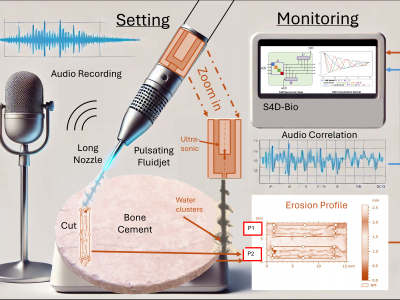Machine Learning

The necessity for strong security measures to fend off cyberattacks has increased due to the growing use of Industrial Internet of Things (IIoT) technologies. This research introduces IoTForge Pro, a comprehensive security testbed designed to generate a diverse and extensive intrusion dataset for IIoT environments. The testbed simulates various IIoT scenarios, incorporating network topologies and communication protocols to create realistic attack vectors and normal traffic patterns.
- Categories:
 223 Views
223 ViewsThis dataset comprises extensive multi-modal data related to the experimental study of ultrasonically excited pulsating fluid jets used for bone cement removal. Conducted at the Institute of Geonics, Ostrava, Czech Republic, the study explores the effect of varying standoff distances on erosion profiles, under controlled parameters including a fixed nozzle diameter, sonotrode frequency, supply pressure, and robot arm velocity. The dataset includes numerical data representing ablation profiles, captured as a large CSV file, and audio recordings captured using a high-resolution microphone.
- Categories:
 167 Views
167 ViewsThe IARPA WRIVA program aims to develop software systems that can create photorealistic, navigable 3D site models using a highly limited corpus of imagery, to include ground level imagery, surveillance height imagery, airborne altitude imagery, and satellite imagery. Additionally, where imagery lacks metadata indicating geolocation, information about camera parameters, or is corrupted by artifacts, WRIVA seeks to detect and correct these factors to incorporate the imagery in site-modelling and other downstream image processing and analysis algorithms.
- Categories:
 306 Views
306 Views
M. Kacmajor and J.D. Kelleher, "ExTra: Evaluation of Automatically Generated Source Code Using Execution Traces" (submitted to IEEE TSE)
- Categories:
 19 Views
19 Views
M. Kacmajor and J.D. Kelleher, "ExTra: Evaluation of Automatically Generated Source Code Using Execution Traces" (submitted to IEEE TSE)
- Categories:
 38 Views
38 ViewsTo provide machine learning and data science experts with a more robust dataset for model training, the well-known Palmer Penguins dataset has been expanded from its original 344 rows to 100,000 rows. This substantial increase was achieved using an adversarial random forest technique, effectively generating additional synthetic data while maintaining key patterns and features. The method achieved an impressive accuracy of 88%, ensuring the expanded dataset remains realistic and suitable for classification tasks.
- Categories:
 334 Views
334 ViewsJamming devices present a significant threat by disrupting signals from the global navigation satellite system (GNSS), compromising the robustness of accurate positioning. The detection of anomalies within frequency snapshots is crucial to counteract these interferences effectively. A critical preliminary measure involves the reliable classification of interferences and characterization and localization of jamming devices.
- Categories:
 190 Views
190 Views
This dataset offers both Channel State Information (CSI) and Beamforming Feedback Information (BFI) data for human activity classification, featuring 20 distinct activities performed by three subjects across three environments. Collected in both line-of-sight (LoS) and non-line-of-sight (NLoS) scenarios, this dataset enables researchers to explore the complementary roles of CSI and BFI in activity recognition and environmental characterization.
- Categories:
 105 Views
105 Views
This dataset enables advanced Wi-Fi sensing applications, including multi-subject monitoring for home surveillance, remote healthcare, and entertainment. It focuses on Beamforming Feedback Information (BFI) as a proxy for Channel State Information (CSI), eliminating the need for firmware modifications and enabling single-capture data collection across multiple channels between an access point (AP) and stations (STAs).
- Categories:
 90 Views
90 Views
As various modalities of genomic data are accumulating, methods to integrate across multi-omics datasets are becoming important. Error-correcting output codes (ECOC) is an ensemble learning strategy for solving a multiclass problem thru a decoding process that aggregates the predictions of multiple classifiers. Thus, it lends itself naturally to aggregating predictions across multiple views as well. We applied the ECOC to multi-view learning to see if this strategy can enhance classifier performance as compared to traditional techniques.
- Categories:
 44 Views
44 Views

